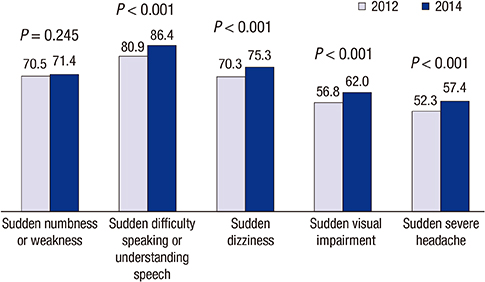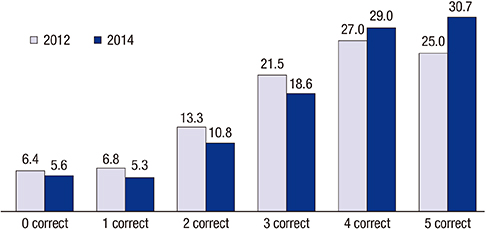J Korean Med Sci.
2016 Nov;31(11):1703-1710. 10.3346/jkms.2016.31.11.1703.
Public Awareness of Stroke and Its Predicting Factors in Korea: a National Public Telephone Survey, 2012 and 2014
- Affiliations
-
- 1Jeonbuk Regional Cardiocerebrovascular Center, Wonkwang University Hospital, Iksan, Korea. lyh8275@hanmail.net
- 2Gangwon Regional Cardiocerebrovascular Disease Center, Kangwon National University Hospital, Chuncheon, Korea.
- 3Daegu-Gyeongbuk Regional Cardiocerebrovascular Disease Center, Kyungpook National University Hospital, Daegu, Korea.
- 4Jeju Regional Cardiocerebrovascular Disease Center, Jeju National University Hospital, Jeju, Korea.
- 5Gyeongnam Regional Cardiocerebrovascular Disease Center, Gyeongsang National University Hospital, Jinju, Korea.
- 6Gwangju-Jeonnam Regional Cardiocerebrovascular Disease Center, Chonnam National University Hospital, Gwangju, Korea.
- 7Chungbuk Regional Cardiocerebrovascular Disease Center, Chungbuk National University Hospital, Cheongju, Korea.
- 8Busan-Ulsan Regional Cardiocerebrovascular Disease Center, Dong-A University Hospital, Busan, Korea.
- 9Daejeon-Chungnam Regional Cardiocerebrovascular Disease Center, Chungnam National University Hospital, Daejeon, Korea.
- 10Gyeonggi Regional Cardiocerebrovascular Disease Center, Seoul National University Bundang Hospital, Seongnam, Korea.
- 11Incheon Regional Cardiocerebrovascular Disease Center, Inha University Hospital, Incheon, Korea.
- 12Department of Preventive Medicine, School of Medicine, Konkuk University, Seoul, Korea.
- 13Division of Chronic Disease Control, Korea Centers for Disease Control and Prevention, Cheongju, Korea.
- 14Department of Preventive Medicine & Institute of Wonkwang Medical Science, Wonkwang University School of Medicine, Iksan, Korea.
- KMID: 2470264
- DOI: http://doi.org/10.3346/jkms.2016.31.11.1703
Abstract
- The aim of this study was to investigate time trends in the public awareness of stroke and its predicting factors. The target population was 9,600 community-dwelling adults, aged 19-79 years, in 16 metropolitan cities and provinces in Korea. The survey samples in 2012 and 2014 were selected separately (entirely different sets of subjects) using a proportionate quota sampling method. Information concerning knowledge of stroke and demographics was collected by trained telephone interviewers using random digit dialing. After excluding subjects with a non-response or refusal to answer any question, the analyses included 8,191 subjects in 2012 and 8,127 subjects in 2014. Respondents' awareness of stroke warning signs (numbness or weakness, difficulty speaking or understanding speech, dizziness, visual impairment, and severe headache) was highest for difficulty speaking or understanding speech (80.9% in 2012 and 86.4% in 2014). There were significant increases in the proportion of respondents understanding the appropriate action (i.e., calling an ambulance) at the time of stroke occurrence (59.6% to 67.1%), and in the proportion aware of the general need for prompt treatment (86.7% to 89.8%). In multivariable logistic regression analysis, older age, higher education level, higher household income, current non-smoking, exposure to stroke-related public relations materials, and experience of stroke education were significantly associated with both high knowledge of stroke warning signs and awareness of the need for prompt treatment. Between 2012 and 2014, the public's awareness of stroke increased significantly. More specialized interventions, including public relations materials and education, should focus on subgroups who have lower stroke knowledge.
Keyword
MeSH Terms
Figure
Cited by 1 articles
-
Factors Related to Awareness of Cardiocerebrovascular Disease among Korean Adults: the 2013 Community Health Survey
Young-Hoon Lee, Se-Eung Noh
Korean J Health Promot. 2017;17(2):99-108. doi: 10.15384/kjhp.2017.17.2.99.
Reference
-
1. Statistics Korea. Causes of death in South Korea [Internet]. accessed on 5 August 2015. Available at http://www.index.go.kr/potal/main/EachDtlPageDetail.do?idx_cd=1012.2. Lee SW, Kim HC, Lee HS, Suh I. Thirty-year trends in mortality from cardiovascular diseases in Korea. Korean Circ J. 2015; 45:202–209.3. Lee SW, Kim HC, Lee HS, Suh I. Thirty-year trends in mortality from cerebrovascular diseases in Korea. Korean Circ J. 2016; 46:507–514.4. Gumbinger C, Reuter B, Stock C, Sauer T, Wiethölter H, Bruder I, Rode S, Kern R, Ringleb P, Hennerici MG, et al. Time to treatment with recombinant tissue plasminogen activator and outcome of stroke in clinical practice: retrospective analysis of hospital quality assurance data with comparison with results from randomised clinical trials. BMJ. 2014; 348:g3429.5. Teuschl Y, Brainin M. Stroke education: discrepancies among factors influencing prehospital delay and stroke knowledge. Int J Stroke. 2010; 5:187–208.6. Kim YS, Park SS, Bae HJ, Cho AH, Cho YJ, Han MK, Heo JH, Kang K, Kim DE, Kim HY, et al. Stroke awareness decreases prehospital delay after acute ischemic stroke in Korea. BMC Neurol. 2011; 11:2.7. Brice JH, Griswell JK, Delbridge TR, Key CB. Stroke: from recognition by the public to management by emergency medical services. Prehosp Emerg Care. 2002; 6:99–106.8. Pandian JD, Jaison A, Deepak SS, Kalra G, Shamsher S, Lincoln DJ, Abraham G. Public awareness of warning symptoms, risk factors, and treatment of stroke in northwest India. Stroke. 2005; 36:644–648.9. Wahab KW, Okokhere PO, Ugheoke AJ, Oziegbe O, Asalu AF, Salami TA. Awareness of warning signs among suburban Nigerians at high risk for stroke is poor: a cross-sectional study. BMC Neurol. 2008; 8:18.10. Kleindorfer D, Khoury J, Broderick JP, Rademacher E, Woo D, Flaherty ML, Alwell K, Moomaw CJ, Schneider A, Pancioli A, et al. Temporal trends in public awareness of stroke: warning signs, risk factors, and treatment. Stroke. 2009; 40:2502–2506.11. Hickey A, O’Hanlon A, McGee H, Donnellan C, Shelley E, Horgan F, O’Neill D. Stroke awareness in the general population: knowledge of stroke risk factors and warning signs in older adults. BMC Geriatr. 2009; 9:35.12. Bray JE, Johnson R, Trobbiani K, Mosley I, Lalor E, Cadilhac D; National Stroke Foundation. Australian public’s awareness of stroke warning signs improves after national multimedia campaigns. Stroke. 2013; 44:3540–3543.13. Park BS, Lee JM, Koh SB, Kim BJ, Park MK, Park KW, Sin C, Lee DH. Ansan citizen’s knowledge of stroke. J Korean Neurol Assoc. 2002; 20:339–345.14. Park MH, Jo SA, Jo I, Kim E, Eun SY, Han C, Park MK. No difference in stroke knowledge between Korean adherents to traditional and western medicine - the AGE study: an epidemiological study. BMC Public Health. 2006; 6:153.15. Lee YH, Shin MH, Kweon SS, Choi JS, Park MS, Cho KH, Lim YS. Awareness of stroke warning signs and risk factors: result of a 2010 community survey in Gwangju Metropolitan City. J Korean Neurol Assoc. 2012; 30:26–32.16. Kim YS, Park SS, Bae HJ, Heo JH, Kwon SU, Lee BC, Lee SH, Oh CW, Yoon BW. Public awareness of stroke in Korea: a population-based national survey. Stroke. 2012; 43:1146–1149.17. Kim WJ, Ko Y, Park JH, Ban B, Han MK, Cho YJ, Bae HJ. Validation of five cardinal symptoms used for stroke awareness campaign. J Korean Neurol Assoc. 2013; 31:15–20.18. Jones SP, Jenkinson AJ, Leathley MJ, Watkins CL. Stroke knowledge and awareness: an integrative review of the evidence. Age Ageing. 2010; 39:11–22.19. Mochari-Greenberger H, Towfighi A, Mosca L. National women’s knowledge of stroke warning signs, overall and by race/ethnic group. Stroke. 2014; 45:1180–1182.20. Kim J, Hwang YH, Kim JT, Choi NC, Kang SY, Cha JK, Ha YS, Shin DI, Kim S, Lim BH. Establishment of government-initiated comprehensive stroke centers for acute ischemic stroke management in South Korea. Stroke. 2014; 45:2391–2396.21. Nicol MB, Thrift AG. Knowledge of risk factors and warning signs of stroke. Vasc Health Risk Manag. 2005; 1:137–147.22. Schneider AT, Pancioli AM, Khoury JC, Rademacher E, Tuchfarber A, Miller R, Woo D, Kissela B, Broderick JP. Trends in community knowledge of the warning signs and risk factors for stroke. JAMA. 2003; 289:343–346.23. Sug Yoon S, Heller RF, Levi C, Wiggers J, Fitzgerald PE. Knowledge of stroke risk factors, warning symptoms, and treatment among an Australian urban population. Stroke. 2001; 32:1926–1930.
- Full Text Links
- Actions
-
Cited
- CITED
-
- Close
- Share
- Similar articles
-
- Stroke Awareness in Korea : The Results of Survey in the Second Stroke Prevention Campaign
- Awareness of Stroke Warning Signs and Risk Factors: Result of a 2010 Community Survey in Gwangju Metropolitan City
- A Survey on Awareness of Health Education in the Manpower of Public Health Center
- Survey on Public Awareness of Neurology in Korea
- Stroke: Morbidity, Risk Factors, and Care in Taiwan



